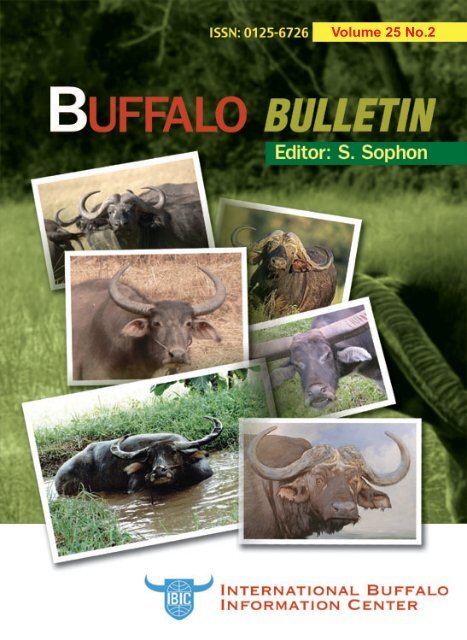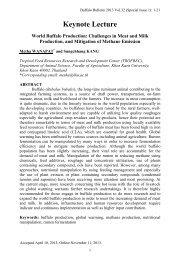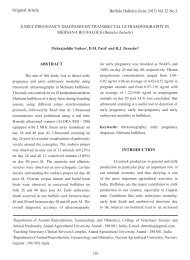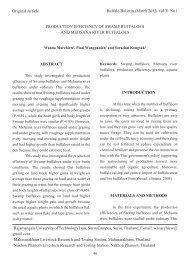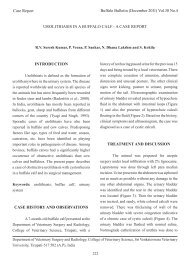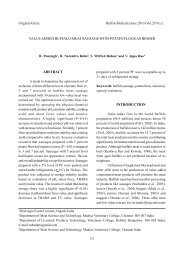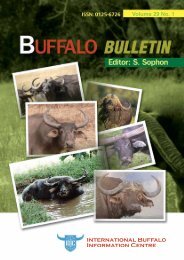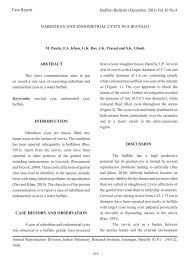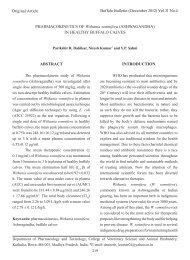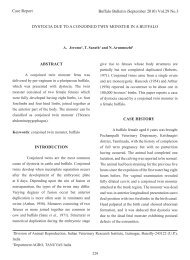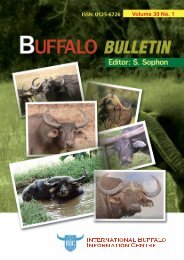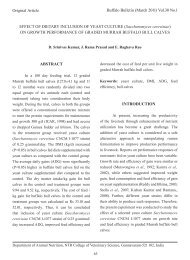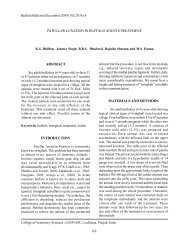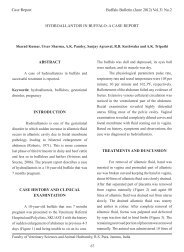copy of BB25-21 - International Buffalo Information Centre
copy of BB25-21 - International Buffalo Information Centre
copy of BB25-21 - International Buffalo Information Centre
You also want an ePaper? Increase the reach of your titles
YUMPU automatically turns print PDFs into web optimized ePapers that Google loves.
Volume 25 No.2
<strong>International</strong> <strong>Buffalo</strong> <strong>Information</strong> Center<br />
Aims<br />
(IBIC)<br />
IBIC is a specialized information center on<br />
water buffalo. Established in 1981 by Kasetsart<br />
University (Thailand) with an initial financial<br />
support from the <strong>International</strong> Development<br />
Research Center (IDRC) <strong>of</strong> Canada. IBIC aims at<br />
being the buffalo information center <strong>of</strong> buffalo<br />
research community through out the world.<br />
Main Objectives<br />
1. To be world source on buffalo<br />
information<br />
2. To provide literature search and<br />
photo<strong>copy</strong> services<br />
3. To disseminate information in<br />
newsletter<br />
4. To publish occasional publications<br />
such as an inventory <strong>of</strong> ongoing<br />
research projects<br />
BUFFALO BULLETIN<br />
ISSN : 0125-6726<br />
<strong>Buffalo</strong> Bulletin is published quarterly in<br />
March, June, September and December.<br />
Contributions on any aspect <strong>of</strong> research or<br />
development, progress reports <strong>of</strong> projects and<br />
news on buffalo will be considered for publication<br />
in the bulletin. Manuscripts must be<br />
written in English and follow the instruction for<br />
authors which describe at inside <strong>of</strong> the back cover.<br />
Editor<br />
S. Sophon<br />
Publisher<br />
<strong>International</strong> <strong>Buffalo</strong> <strong>Information</strong> <strong>Centre</strong>,<br />
Main Library, Kasetsart University<br />
Online availible:<br />
http://ibic.lib.ku.ac.th/e-Bulletin<br />
BUFFALO BULLEITN<br />
IBIC, KASETSART UNIVERSITY, P.O. BOX 1084<br />
BANGKOK 10903, THAILAND<br />
URL : http://ibic.lib.ku.ac.th<br />
E-mail : libibic@ku.ac.th<br />
Tel : 66-2-9428616 ext. 344<br />
Fax : 66-2-9406688
25<br />
<strong>Buffalo</strong> Bulletin (June 2006) Vol.25 No.2<br />
RUMINAL pH AS REGULATOR OF RUMEN METABOLISM IN BUFFALOES<br />
The importance <strong>of</strong> the buffalo as a dairy<br />
animal is due to its ability to produce milk efficiently,<br />
effectively and economically. The process <strong>of</strong><br />
conversion <strong>of</strong> feed into milk is complicated and is<br />
dependent upon the ruminal environment. The type<br />
<strong>of</strong> diet affects the rumen environment by changing<br />
its pH, causing various digestive disorders<br />
influencing the metabolic activity: hypo-galactia and<br />
agalactia. The present study was, therefore,<br />
undertaken to investigate the effect <strong>of</strong> changes in<br />
pH on rumen metabolism and production in lactating<br />
Murrah buffaloes.<br />
Materials and Methods<br />
A total 144 clinical cases <strong>of</strong> buffaloes <strong>of</strong> third/<br />
fourth lactation (12 months) suffering from primary<br />
indigestion were studied for one year at the<br />
Veterinary Clinics <strong>of</strong> the University. Similarly, a total<br />
120 buffaloes (10 per month) at the same lactation<br />
were randomly selected and maintained on normal<br />
farm schedule at the Animal Farm <strong>of</strong> the University.<br />
Rumen samples were collected from these animals<br />
at monthly intervals. The pH strip was used<br />
immediately to assess the pH <strong>of</strong> rumen liquor and<br />
later the pH <strong>of</strong> strained rumen liquor (SRL) was<br />
measured for confirmation. Total counts <strong>of</strong> rumen<br />
protozoa and bacteria were done following the<br />
method described by Moir (1951) and Gall et al.<br />
(1945) and their classification were done as per the<br />
method described by Pounden and Hibs (1948). The<br />
total and individual volatile fatty acids were<br />
analyzed by using gas chromatography (Bernard and<br />
Bouchque, 1968). Ruminal biogenic amines were<br />
estimated by HPLC (Kochler and Eitenmiller, 1975).<br />
M.A. Akbar and Ramesh Kumari<br />
Results and Discussion<br />
For the past last thirteen years, studies were<br />
carried out on 144 clinical cases and 120 healthy<br />
buffaloes <strong>of</strong> third/fourth lactation every year. Out <strong>of</strong><br />
144 clinical cases <strong>of</strong> buffaloes, three cases (2.08%)<br />
<strong>of</strong> bloat, six cases (4.17%) <strong>of</strong> acidic indigestion, <strong>21</strong><br />
cases <strong>of</strong> impaction (14.58%) and 114 cases (79.16%)<br />
<strong>of</strong> alkaline indigestion were observed.<br />
The mean pH value <strong>of</strong> strained rumen<br />
liquor (SRL) ranged from 6.99 to 7.3 in healthy<br />
animals and 5.5 to 8.9 in digestive disorder cases.<br />
On the basis <strong>of</strong> pH value, the clinical cases were<br />
categorized into four kind <strong>of</strong> indigestion, viz., bloat<br />
(pH 5.52 to 5.72), acidic indigestion (pH 5.73 to 6.99),<br />
impaction (pH 7.00 to 7.49) and alkaline indigestion<br />
(pH 7.5 to 8.9) as shown in the Table . The above<br />
categorization on the basis <strong>of</strong> pH corroborates with<br />
the reports <strong>of</strong> Bhaskar (1971), Gupta et al. (1976)<br />
and Choudhary et al. (1981).<br />
Most <strong>of</strong> the cases had alkaline indigestion<br />
and had a history <strong>of</strong> feeding on too much sorghum,<br />
pearl millet and berseem fodder. It was observed<br />
that acidic indigestion occurred due to excessive<br />
feeding on dry ration and grains. The consumption<br />
<strong>of</strong> rotten wheat straw, pearl millet stover and paddy<br />
straw caused impaction while the cases <strong>of</strong> bloat<br />
were due to excessive intake <strong>of</strong> green fodders like<br />
lucerne, mustard, etc.<br />
On microscopic examination <strong>of</strong> SRL, the<br />
predominant genera <strong>of</strong> protozoa found were<br />
Entodenia followed by Isotricha and Dasytricha at<br />
pH 5.5 to 8.9 in both healthy and anorexic<br />
buffaloes. Other protozoan species like Entodinium<br />
bursa, Diplodinium dentatum, Polyplastron<br />
multivesiculatum were observed only in healthy<br />
buffaloes. The bacteria Oscillospira guillermondii<br />
College <strong>of</strong> Animal Sciences, CCS Haryana Agricultural University, Hisar-125 004, India
<strong>Buffalo</strong> Bulletin (June 2006) Vol.25 No.2<br />
was also found in these animals during winter months,<br />
and this is an index <strong>of</strong> positive nitrogen balance in<br />
healthy buffaloes. Entodenia species like E. simplex,<br />
E. bicarinatum, E. triacum and E. elongatum were<br />
seen in healthy buffaloes at pH 6.99 to 7.30.<br />
These species are very rarely found in buffaloes<br />
suffering from primary indigestion because these are<br />
very sensitive to pH changes in the rumen (Hungate,<br />
1966).<br />
Rumen bacteria like Gram negative short rods<br />
in fours and multiples <strong>of</strong> four suggestive <strong>of</strong> window<br />
pans (Hay flora, group II-c) remained prominent in<br />
healthy as well as in buffaloes suffering from<br />
indigestion. Gram positive cocci singly or in long<br />
chains, Gram negative rods resembling coli form<br />
organisms, grain flora group-II, large Gram positive<br />
cocci in closely knit-pairs or tetrads, hay flora group<br />
I and medium sized comparatively thin Gram<br />
positive rods or grain flora group-I were present in<br />
addition to miscellaneous organisms like quoin’s oval<br />
in healthy buffaloes. In clinical cases, small Gram<br />
negative rods (F-type grain flora group-II) in<br />
alkaline pH 7.5 to 8.9 and the gram positive cocci<br />
were predominant after d-type flora in impaction at<br />
pH 7.0 to 7.4. In the cases <strong>of</strong> acidic (pH 5.5 to 6.9)<br />
only a particular species, i.e. Gram positive cocci,<br />
dominated because other species are very sensitive<br />
and required a specific pH and the proper substrate<br />
for their role and activity. These observations<br />
corroborate with the findings <strong>of</strong> other workers<br />
(Ryan, 1964; Hungate, 1966), which indicated that<br />
the number <strong>of</strong> species was higher in the control group<br />
due to favourable pH and proper substrate to<br />
survive and thrives.<br />
The total protozoan count ranged from 4.35<br />
x 10 5 /ml to 7.26x10 5 /ml at normal pH from 6.99 to<br />
7.3 in healthy animals. In clinical cases where pH<br />
varied from 5.5 to 8.9 the total protozoan count<br />
ranged from 2.35 to 4.12 x10 5 /ml, which was<br />
significantly (P
et al., loc. cit.).<br />
The levels <strong>of</strong> ruminal biogenic amines, i.e.<br />
histamine, tryptamine and tyramine, have positive<br />
correlation with milk production (Singh et al., 1989).<br />
Any kind <strong>of</strong> deviation in ruminal pH directly affects<br />
the levels <strong>of</strong> biogenic amines and hence milk<br />
production. The ruminal histamine level was found<br />
to be more than double in bloat, i.e. at pH 5.00 to<br />
5.50, and towards higher side in acidic indigestion,<br />
where the pH was 5.60 to 6.90. High levels <strong>of</strong><br />
histamine in the above cases was responsible for<br />
rumen atony and loss <strong>of</strong> appetite, thereby, reducing<br />
metabolic activity and ultimately milk production.<br />
The lower level <strong>of</strong> histamine in impaction and<br />
alkaline indigestion, where the pH ranged from 7.5<br />
to 8.9, was also observed to be associated with lower<br />
milk production (Irwin et al., 1972; Gupta et al., loc.<br />
cit.; Chaudhary et al., loc. cit.).<br />
Ruminal tryptamine and tyramine levels<br />
were found highest in alkaline indigestion followed<br />
by impaction, acidic indigestion and bloat. Their<br />
levels increased due to decarboxylation <strong>of</strong> tryptopha<br />
and tyrosine for which optimum pH was observed<br />
to be 7.00 to 8.90. These observations do not<br />
correspond with the findings <strong>of</strong> Irwin et al. (loc. cit.;<br />
1979). They reported higher values <strong>of</strong> these amines<br />
at 10 per cent dietary protein level and the optimum<br />
pH for decarboxylation was 5.5, while in the present<br />
investigations it was observed to be alkaline. The<br />
decarboxylation <strong>of</strong> tyrosine by mixed bacteria may<br />
continue to occur when pH is in the neutral or in the<br />
27<br />
<strong>Buffalo</strong> Bulletin (June 2006) Vol.25 No.2<br />
alkaline range. On the other hand, higher level <strong>of</strong><br />
tryptamine was probably due to its endogenous<br />
release even at low protein concentration in the<br />
rumen liquor. The higher level <strong>of</strong> both the amines<br />
reduced the rumen motility, causing rumen atony<br />
and various digestive disorders. This resulted in<br />
reduced feed intake, low metabolic activity and<br />
hence lower milk production through inhibition <strong>of</strong><br />
galactopoietic hormones and release <strong>of</strong><br />
catecholamine further impairing the action <strong>of</strong><br />
oxytocin towards release <strong>of</strong> milk.<br />
Summary<br />
Studies conducted on clinical cases <strong>of</strong><br />
lactating buffaloes suffering from primary<br />
indigestion revealed that ruminal pH is one <strong>of</strong> the<br />
most important factors. Any deviation in ruminal pH<br />
causes different kinds <strong>of</strong> indigestion, which disrupt<br />
the rumen environment resulting in reduced<br />
metabolic activities and ultimately inhibiting milk<br />
production.<br />
Acknowledgement<br />
Authors are thankful to Dr. Narendra Singh,<br />
former Dean, College <strong>of</strong> Animal Sciences <strong>of</strong> this<br />
University, for providing research facilities to carry<br />
out this work under the National Fellow (ICAR)<br />
project.
<strong>Buffalo</strong> Bulletin (June 2006) Vol.25 No.2<br />
Table1 Microbial counts, VFA and biogenic amines found in rumen liquor <strong>of</strong> buffaloes suffering from<br />
primary indigestion.<br />
Attribute Digestive disorders<br />
Healthy Bloat Acidic Impaction Alkaline<br />
animals indigestion indigestion<br />
pH 7.30±0.05 5.70±0.05 6.60±0.10 7.10±0.04 8.20±0.04<br />
Total protozoan<br />
counts (nx10 5 /ml) 5.59±0.39 1.50±0.04 4.18±0.20 4.59±0.06 3.14±0.07<br />
Total bacterial<br />
counts (nx10 9 /ml) 6.77±0.<strong>21</strong> 3.14±0.02 4.70±0.15 4.22±0.04 4.94±0.09<br />
TVFA (m.eq./l) 110.09±6.73 50.02±0.76 51.30±1.033 53.08±0.68 54.63±0.26<br />
Acetic acid (%) 70.42±2.02 54.69±0.94 55.23±1.46 56.62±0.68 54.63±0.26<br />
Propionic acid (%) 14.06±0.73 30.13±0.32 28.51±0.22 24.76±0.34 22.62±0.12<br />
Butyric acid (%) 10.93±0.29 7.38±0.09 8.09±0.06 9.61±0.06 10.14±0.03<br />
Ruminal biogenic amines ( µg/ml)<br />
Histamine 0.513±0.004 1.084±0.005 0.864±0.013 0.198±0.003 0.203±0.003<br />
Tryptamine 0.298±0.004 0.285±0.001 0.351±0.001 0.460±0.008 0.453±0.003<br />
Tyramine 0.268±0.004 0.197±0.001 0.<strong>21</strong>1±0.002 0.277±0.006 0.357±0.002<br />
28
REFERENCES<br />
Ash, R.M. 1956. In: The Rumen and its Microbes.<br />
Hungate R.E., ed. Academic Press, New York.<br />
J. Physiol. 133: 75-78.<br />
Bernard, G.C. and C.V. Bouchque. 1968. Rapid<br />
method for the gas chromatographic<br />
determination <strong>of</strong> volatile fatty acids in rumen<br />
fluid. J. Agric. Food Chem. 16: 105-108.<br />
Bhaskar, V.K. 1971.Studies on some <strong>of</strong> the<br />
clinico-pathological aspects <strong>of</strong> indigestion<br />
in buffaloes and cattle. M.V.Sc. Thesis,<br />
Haryana Agricultural University, Hisar.<br />
Choudhary, P.C., B. Prasad and S.K. Misra 1981.<br />
Note on the use <strong>of</strong> rumen liquor in the<br />
treatment <strong>of</strong> chronic alkaline indigestion in<br />
cows. Indian J. Anim. Sci. 51: 356-360.<br />
Dirksen, G. 1970. In: Physiology <strong>of</strong> Digestion and<br />
Metabolism in the Ruminants. Phillipson, A.T.<br />
ed. Oriels Press, London. p. 692.<br />
Gall, L.S., W. Burroughs, P. Gerlaugh and B.H.<br />
Edginton 1945. Special methods for rumen<br />
bacterial studies in the field. J. Anim. Sci. 8:<br />
433-436.<br />
Gupta, G.C., B.P. Joshi and P. Rai. 1976. A note on<br />
histamine concentration in rumen fluid and<br />
blood in tropical bovine suffering from<br />
indigestion. J. Anim. Sci. 46: 319-3<strong>21</strong>.<br />
Hungate, R.E. 1966. The Rumen and its Microbes.<br />
Academic Press, New York.p.434.<br />
Irwin, L.N., Jr. Mitchel, R.E. Tucker and G.T.<br />
Shelling, 1972. Amine production by sheep with<br />
glucose. J. Anim. Sci. 35: 267-271.<br />
29<br />
<strong>Buffalo</strong> Bulletin (June 2006) Vol.25 No.2<br />
Irwin, L.N., G.E. Mitchell, R.E. Tucker and G.T.<br />
Shelling. 1979. Histamine, tryptamine and<br />
tyramine, and electrolytes during glucose<br />
induced lactic acidosis. J. Anim. Sci.<br />
48: 367-374.<br />
Kochler, P.E. and R.R. Eitenimller. 1975.High<br />
pressure liquid chromotatographic analysis <strong>of</strong><br />
tyramine, phenyl ethylamine and tryptamine in<br />
sausage and chocolate. J. Food Sci.<br />
43: 1245-1249.<br />
Moir, R.J. 1951. The seasonal variation in the<br />
ruminal micro organisms <strong>of</strong> grazing sheep.<br />
Australian J. Agric. Res. 2: 322-331.<br />
Pounden, W.D. and J.W. Hibs. 1948. The influence<br />
<strong>of</strong> the ratio <strong>of</strong> grain to hay in the ration <strong>of</strong> dairy<br />
calves in certain rumen micoorganisms.<br />
J. Dairy Sci. 31: 1051-1057.<br />
Ryan, R.K. 1964. In: The Rumen and its Microbes.<br />
Ed. Hungate R.E., Academic Press, New York.<br />
Am. J. Vet. Res., 25: 646-648.<br />
Singh, N., J.P. Puri, O.P. Nangia and S.L. Garg.<br />
1983. Early development <strong>of</strong> rumen function in<br />
buffalo calves: Rumen microbes, metabolites<br />
and cellulose digestion in vitro as a function <strong>of</strong><br />
age and diet. Indian J. Anim. Sci.<br />
53: 933-938.<br />
Singh, N., Kumari, R. and Akbar, M.A. 1989.<br />
Effect <strong>of</strong> biogenic amines on milk production.<br />
Indian J. Anim. Sci. 59: 1319-1323.
<strong>Buffalo</strong> Bulletin (June 2006) Vol.25 No.2<br />
A SIGNIFICANT OBSERVATION ON THE STATUS OF CORTISOL IN NEONATAL BUFFALO<br />
CALVES AND COW CALVES VIS-À -VIS THEIR DAMS<br />
ABSTRACT<br />
Cortisol levels were measured through ELISA<br />
in 85 animals inclusive <strong>of</strong> periparturient dams and<br />
their calves up to 91 days <strong>of</strong> life. The levels were<br />
lower in the dams but in the early neonatal periods<br />
the cortisol levels were significantly (P
RESULTS AND DISCUSSION<br />
The values <strong>of</strong> serum cortisol in the periparturient<br />
buffaloes and cows and their respective neonatal<br />
calves have been presented in Table 2. The levels<br />
<strong>of</strong> cortisol in the periparturient dams remained<br />
almost identical. However, in the neonatal calves,<br />
particularly within a month period, the cortisol levels<br />
were significantly (p
<strong>Buffalo</strong> Bulletin (June 2006) Vol.25 No.2<br />
Table 2. Status <strong>of</strong> serum cortisol <strong>of</strong> neonatal buffalo calves and cow calves along with their dams at different<br />
periods.<br />
Parameters Serum cortisol (µg/dl)<br />
Dams <strong>Buffalo</strong>es Cows<br />
Pre-partum 1.5±0.3 1.6±0.2<br />
Post-partum 1.3±0.1 1.5±0.2<br />
Calves Bc Cc<br />
Pre-colostrum feeding 4.2±3.3* 4.5±0.8<br />
6 h Post Colostrum feeding 7.2±2.8 7.8±1.4<br />
1 st day 11.0±4.0* 8.4±2.0*<br />
2 nd day 5.4±4.0 9.6±3.0<br />
3 rd day 7.4±3.0 6.4±2.0<br />
4 th day 8.0±4.0 7.0±3.0<br />
5 th day 6.0±5.0 12.0±4.0<br />
6 th day 9.0±6.0 10.0±4.0<br />
14 th day 4.6±4.0 5.7±2.0<br />
<strong>21</strong> th day 4.0±0.4 8.0±4.0<br />
28 th day 5.0±0.7 9.0±5.6<br />
35 th day 3.0±2.0 6.0±3.0<br />
42 th day 3.0±1.0 5.0±2.0<br />
49 th day 3.0±1.0 4.0±1.0<br />
56 th day 3.0±0.6 4.0±1.0<br />
63 th day 5.0±1.0 3.0±1.3<br />
70 th day 3.0±0.5 3.0±1.0<br />
32
Contd.<br />
*P
<strong>Buffalo</strong> Bulletin (June 2006) Vol.25 No.2<br />
PROFILE OF SERUM IMMUNOGLOBULINS, GLUCOSE- 6-PHOSPHATE<br />
DEHYDROGENASE AND L: N RATIO AS A MEASURE OF INTERNAL DEFENSE OF<br />
NEONATAL BOVINE CALVES VS THEIR DAM : EFFECT OF NEEM OIL AS<br />
IMMUNOMODULATOR<br />
A.K. Jain, I. J. Sharma, M.A. Quadri, R.K. Tripathi and R.G.Agrawal<br />
ABSTRACT<br />
The internal defense <strong>of</strong> the animals is<br />
accomplished through the combined effort <strong>of</strong> blood<br />
cells and different immunoglobulins. The levels <strong>of</strong><br />
immunoglobulins were higher in sera samples <strong>of</strong><br />
periparturient buffaloes while reverse was true for<br />
the levels in the colostrum. The immunoglobulin<br />
content in the serum <strong>of</strong> buffalo calves after<br />
colostrum feeding was lower that in sera <strong>of</strong> cow<br />
calves. This clearly indicates poor absorption <strong>of</strong><br />
immunoglobulins from the gastrointestinal tract <strong>of</strong><br />
buffalo calves. The L:N ratio was also low in the<br />
buffalo calves, whereas G-6PD was higher. Together<br />
the low immunoglobulin and L: N ratio reduce the<br />
immunocompetence <strong>of</strong> the buffalo calves.<br />
Keyword: neonate, postpartum, immunology,<br />
glucose-6-phosphate dehydrogenase, neem oil,<br />
calves<br />
INTRODUCTION<br />
In bovines, the maternal transfer <strong>of</strong><br />
immunoglobulins through placenta is very little.<br />
Maternal colostrum accumulates and provides the<br />
immunoglobulins to the newborn calves, which give<br />
passive immunity to the calves. Variation in the<br />
immunoglobulin levels in neonates <strong>of</strong> different<br />
genotypes was reported by Sangwan et al. (1987).<br />
The death <strong>of</strong> the buffalo calves within 15 days was<br />
reported by Sikka and Seth (1996) due to poor<br />
Jawaharlal Nehru Krishi Vishwa Vidyalaya,Jabalpur,Madhya Pradesh 482001 (M.P.)India<br />
34<br />
absorption <strong>of</strong> immunoglobulin from the gastrointestinal<br />
tract. Internal defense is the result <strong>of</strong><br />
a combined effort <strong>of</strong> blood cells and serum<br />
immunoglobulins. Gupta et al. (1990) pointed out that<br />
the foetuses <strong>of</strong> buffalo calves had negligible amounts<br />
<strong>of</strong> immunoglobulins in their serum. Later on after<br />
birth 70% <strong>of</strong> young calves had more than 15mg%<br />
due to absorption <strong>of</strong> colostral immunoglobulins<br />
through intestinal villi. The L:N ratio is important from<br />
viewpoint <strong>of</strong> defense through antibody secretion.<br />
The G-6PD is the first line <strong>of</strong> defense <strong>of</strong> the body<br />
(Ganong, 1999). The interassociation <strong>of</strong> other<br />
related cellular parameters and serum<br />
immunoglobulins with high mortality <strong>of</strong> the neonatal<br />
buffalo calves is not clear. In an attempt to work<br />
out the possible cause <strong>of</strong> the heavy toll <strong>of</strong> neonatal<br />
buffalo calves, this project was envisaged.<br />
MATERIALS AND METHODS<br />
The experiment was carried out from<br />
December 1, 2004 to August 2005. The experimental<br />
design and animals used are given in Table 1. The<br />
immunoglobulin levels in the sera samples <strong>of</strong> the<br />
calves and whey portion <strong>of</strong> colostrum <strong>of</strong> their<br />
respective dams were estimated as per the method<br />
<strong>of</strong> Selman et al. (1970) using the ZnSO 4 turbidity<br />
method and the level <strong>of</strong> G-6-PD by the methods <strong>of</strong><br />
Kachmar and Moss (1976) in the red cell<br />
haemolysate using ready-made kits. The
Lymphocyte: Neutrophil (L:N) ratio was calculated<br />
from their respective absolute figures recorded with<br />
a Medonic Thor – 20 Auto cell counter. The<br />
statistical analysis <strong>of</strong> date was done as per Snedecor<br />
and Cochren (1989).<br />
RESULTS AND DISCUSSION<br />
The results <strong>of</strong> serum and colostral<br />
immunoglobulin <strong>of</strong> dams, their L:N ratio and<br />
G-6-PD have been presented in Table 2. The total<br />
immunoglobulin was recorded to be always higher<br />
in the periparturient buffalo sera and colostral<br />
samples in comparison to the periparturient cows.<br />
However, immediately after birth, before colostrum<br />
feeding to the calves <strong>of</strong> both the species, the total<br />
immunoglobulin content was almost nil, but it started<br />
rising 6 h after colostral feeding and thereafter with<br />
a slight ebb during the first week <strong>of</strong> the neonatal<br />
period (Table 3). Administration <strong>of</strong> neem oil<br />
enhanced the immunocompetence <strong>of</strong> the calves as<br />
earlier reported by Katiyar et al. (1997). One fact<br />
was evident from the observation that the levels <strong>of</strong><br />
serum immuno globulins in buffalo calves was<br />
always lower than the cow calves. This might have<br />
been the resultant <strong>of</strong> poor absorption from the G.I.<br />
tract <strong>of</strong> the buffalo calves resulting into low levels<br />
<strong>of</strong> immunoglobulins in serum and high mortality rate<br />
<strong>of</strong> neonatal buffalo calves. Archana et al. (1996)<br />
also reported that the higher environmental<br />
temperature reduces the absorption from G.I. Tract.<br />
The L:N ratio was quite high in periparturient<br />
dams but fell down (Table 3) in the precolostral fed<br />
calves. The ratio increased slowly to adult values<br />
with age. The conspicuous observation was that the<br />
L:N ratio <strong>of</strong> buffalo calves was significantly (P
<strong>Buffalo</strong> Bulletin (June 2006) Vol.25 No.2<br />
Table 1. Place <strong>of</strong> procurement and number <strong>of</strong> the animals.<br />
S. No. Experimentation Condition <strong>of</strong> Animals Location <strong>of</strong> Animals No. <strong>of</strong> animals used Calves died<br />
1. Periparturient <strong>Buffalo</strong>es Reliable Dairy, Gwarighat, Jabalpur 19 -<br />
Periparturient Cows LSF, Adhartal, COVS, Jabalpur 16 -<br />
2. Control <strong>Buffalo</strong> calves Reliable Dairy, Gwarighat, Jabalpur 12 6<br />
Cow calves LSF, Adhartal, COVS, Jabalpur 12 2<br />
36<br />
3. Treated with <strong>Buffalo</strong> calves Reliable Dairy, Gwarighat, Jabalpur 15 7<br />
Neem oil<br />
@ 10ml/Day<br />
Cow calves LSF, Adhartal, COVS, Jabalpur 11 -
Table 2. Status <strong>of</strong> defensive parameters <strong>of</strong> periparturient buffaloes and cows<br />
37<br />
<strong>Buffalo</strong> Bulletin (June 2006) Vol.25 No.2<br />
Stage Animal Total Immunoglobulin (mg/ml) G-6PD (U/g. Hb) L: N ratio<br />
Colostrum Serum<br />
Prepartum <strong>Buffalo</strong>es 127±11 79±15 1.57<br />
Cows 92±16 17±3.3 1.76<br />
Postpartum <strong>Buffalo</strong>es 254±33 202±11 77±12 1.84<br />
Cows 206±32 149±28 22±6.3 4.97
<strong>Buffalo</strong> Bulletin (June 2006) Vol.25 No.2<br />
Table 3. Status <strong>of</strong> defensive parameters <strong>of</strong> neonatal buffalo calves (Bc) and cow calves (Cc) along with<br />
effect <strong>of</strong> Neem oil at different time intervals<br />
Time intervals Neonatal Total immunoglobulin G6PD(U/gm Hb) L: NRatio<br />
(mg/ml)<br />
Calves Control Neemoil treat Control Neemoil treat. Control Neemoil treat.<br />
Precolostral Bc 5.8±0.6 - 107±25 - 0.8±0.1* -<br />
feeding<br />
Cc 4.1±1.0 34±8 1.1±0.1<br />
6 h post Bc 122±30* 123±10 124±<strong>21</strong>* 81±12 0.7±0.1* 0.8±0.1<br />
colost. feed.<br />
Cc 153±34 155±43 26±6.5 <strong>21</strong>±5.2 1.2±0.1 1.1±0.1<br />
1 st Day Bc 65±9.3 78±20 117±15* 112±22 0.8±0.1* 0.8±0.1<br />
Cc 96±25 95±17 23±6.4 33±6.0 1.2±0.1 1.2±0.1<br />
2 nd Day Bc 91±13 86±27 198±17* 122±18 0.8±0.1* 0.8±0.1<br />
Cc 95±19 94±14 24±5.0 38±10 1.4±0.1 1.4±0.1<br />
3 rd Day Bc 98±18 110±25 150±18* 99±23 0.8±0.1* 0.9±0.1<br />
Cc 103±<strong>21</strong> 105±7.6 23±5.0 <strong>21</strong>±5.4 1.5±0.1 1.5±0.1<br />
4 th Day Bc 119±13 111±25 158±25* 109±17 0.8 0* 0.9±0.1<br />
Cc 104±19 108±23 33±4.0 37±10 1.5±0.1 1.6±0.1<br />
5 th Day Bc 123±22 101±20 166±17* 146±61 0.8±0.1* 0.9±0<br />
Cc 134±29 139±16 44±9.2 61±8.1 1.6±0 1.7±0.1<br />
6 th Day Bc 103±27 94±<strong>21</strong> 146±28* 90±25 0.9±0.1* 0.9±0<br />
Cc 113±11 115±13 47±10 16±4.0 1.5±0.1 1.8±0.2<br />
14 th Day Bc 101±22 114±17 56±18 1<strong>21</strong>±24 0.9±0.1* 0.9±0<br />
Cc 110±<strong>21</strong> 140±25 36±9.8 36±9.8 1.5±0.1 1.5±0.3<br />
<strong>21</strong> st Day Bc 109±10 99±31 65±<strong>21</strong> 82±23 1±0.1 1.0±0<br />
Cc 115±26 92±16 38±4.4 35±8.5 1.5±00 2.0±0.1<br />
38
39<br />
<strong>Buffalo</strong> Bulletin (June 2006) Vol.25 No.2<br />
Time intervals Neonatal Total immunoglobulin G6PD(U/gm Hb) L: NRatio<br />
(mg/ml)<br />
Calves Control Neemoil treat Control Neemoil treat. Control Neemoil treat.<br />
28 th Day Bc 125±12 101±18 122±26* 69±24 1.0±00 0.9±0.1<br />
Cc 104±11 124±23 32±12 37±10 1.6±0.1 2.3±0.2<br />
35 th Day Bc 129±15 181±42 108±30* 38±8.9 0.8±0.2* 0.9±0.1<br />
Cc 140±35 155±43 25±7.8 30±9.1 1.5±0.1 2.3±0.2<br />
42 nd Day Bc 90±24* 159±32 33±6.6 67±16 0.8±0.1 0.9±0.1<br />
Cc 148±60 123±15 22±10 44±12 1.4±0.1 2.2±0.2<br />
49 th Day Bc 184±32 90±17 60±<strong>21</strong> 75±28 0.8±0.1* 0.9±0.1<br />
Cc 142±32 171±17 26±3.8 28±6.7 1.5±0.1 2.3±0.1<br />
56 th Day Bc 104±26 92±16 47±15 50±16 0.7±0.1* 0.8±0.1<br />
Cc 139±16 187±39 17±3.8 28±5.8 1.5±0.1 2.3±0.1<br />
63 rd Day Bc 123±22 91±11 123±22 91±11 0.7±0.1* 0.8±0.1<br />
Cc 114±20 141±20 114±20 141±20 1.5±0.1 2.2±0.1<br />
70 th Day Bc 95±13* 92±16 95±13 92±16 0.7±0.1* 0.7±0.1<br />
Cc 174±32 146±29 174±32 146±29 1.4±0.1 2.4±0.1<br />
77 th Day Bc 126±10 123±10 61±20 72±19 0.7±0.1 0.7±0.1<br />
Cc 115±26 148±22 19±3.9 24±2.4 1.6±0.1 2.3±0.4<br />
84 th Day Bc 115±15 108±12 265±14 53±11 0.6±0.1* 0.6±0.1<br />
Cc 104±12 147±20 19±5.8 32±4.7 1.5±0.1 2.3±0.2<br />
91 st Day Bc 107±25 142±19* 65±16 53±11 0.5±0.1* 0.6±0.1*<br />
postpatum Cc 115±25 145±28 31±7.4 33±4.8 1.5±0.1 2.6±0.3<br />
. *P
<strong>Buffalo</strong> Bulletin (June 2006) Vol.25 No.2<br />
HAEMATO-BIOCHEMICAL PROFILES OF BUFFALO IN ANTHELMINTICS TREATMENT<br />
AGAINST FASCIOLA GIGANTICA INFECTION<br />
ABSTRACT<br />
Haemato-biochemical pr<strong>of</strong>iles were studied on<br />
Fasciola gigantica infected buffalo in Triclabendazole,<br />
Rafoxanide and Oxyclozanide treatment<br />
Haemetological analysis showed reduced<br />
erythrocytic count, haemoglobin percent and PCV<br />
level and eosinophilia in all groups before treatment.<br />
The values were improved 15 days after treatment.<br />
But the statistically significant improvement was seen<br />
in eosinophil percent in Rafoxanide and Oxyclozanide<br />
treated animals while Triclabendazole treated<br />
animals showed low level <strong>of</strong> eosinophilia.<br />
Biochemical analysis revealed hypoproteinemia,<br />
hypoalbuminemia, hypoglobulinemia, increased<br />
levels <strong>of</strong> total serum bilirubin, AST, ALT and ALP<br />
before treatment. After treatment, total serum<br />
bilirubin and AST values were decreased significantly<br />
in all treated groups while a significant level <strong>of</strong> total<br />
protein and globulin were found only in Oxyclozanide<br />
treated animals.<br />
INTRODUCTION<br />
Fasciolosis is a serious economic disease <strong>of</strong><br />
livestock with worldwide distribution. Of the three<br />
species (F. hepatica, F. giantica and F. jacksoni)<br />
F. giantica is regarded as one <strong>of</strong> the most important<br />
parasitic infection <strong>of</strong> ruminants in countries with<br />
tropical climates (Boray, 1985; Harrison et al., 1996<br />
and Tantrawatpan et al., 2003). It is a major<br />
constraint for livestock industries due to high<br />
mortality and morbidity (Sharma et al., 1989),<br />
decrease in weight gain (Bhatia et al., 1989 and<br />
S. Pal and C.K. Dasgupta<br />
Department <strong>of</strong> Veterinary Parasitology, West Bengal University <strong>of</strong> Animal and Fishery Sciences, Belgachia,<br />
Kolkata, West Bengal 700 037, India<br />
40<br />
Mandal, 1997), fertility, milk yield and wool<br />
production and liver condemnation (Swarup et al.,<br />
1987). Prevalences <strong>of</strong> F. giantica in fection in some<br />
ruminants range up to 80-100% in many countries<br />
like West Africa (Schillhorn Van Veen, 1980), India<br />
(Sharma et al., 1989) and Pakistan (Kendall, 1954)<br />
etc. Among the different definitive hosts, buffalo is<br />
the susceptible.<br />
Effective strategies for the control <strong>of</strong> fasciolosis<br />
are mainly based on the proper diagnosis and the<br />
use <strong>of</strong> very effective drugs. But, resistance <strong>of</strong> the<br />
liver fluke to flukicides is becoming a great problem<br />
to farmers (Mitchell et al., 1998; Estuningsih, et al.<br />
1990 and Sanyal, 1996). It was therefore, decided<br />
to undertake this study to see the haematobiochemical<br />
changes in buffalo infected with F.<br />
gigantica in leading flukicides therapy.<br />
MATERIALS AND METHODS<br />
Sixteen adult buffaloes (Murrah breed) <strong>of</strong><br />
either sex naturally infected with Fasciola gigantica<br />
at Mayakole, Krishnagar, Nadia, West Bengal were<br />
used for this study. They were divided into four groups<br />
<strong>of</strong> four in each. Animals <strong>of</strong> Group-I were treated<br />
with Triclabendazole (Fasinex, Trend Pharma<br />
Private Ltd.) at 12 mg/kg body weight orally.<br />
Group-II was treated with Rafoxanide (Rafoxin<br />
2000, Concept Pharmaceuticals Ltd.) at 7.5 mg/kg<br />
body weight and Group-III was treated with<br />
Oxyclozanide (Distodin, Pfizer) at 10 mg/kg body<br />
weight orally while Group-IV was left as an untreated<br />
infected control. Efficacy <strong>of</strong> the chemotherapeutic
agents was determined on the basis <strong>of</strong> pre and 15 th<br />
day post-treatment haematological and biochemical<br />
values.<br />
Haematological pr<strong>of</strong>iles:<br />
The blood samples collected in EDTA<br />
(sodium salt <strong>of</strong> ethylenediamine tetraacetic acid)<br />
vials were processed immediately as per the method<br />
describe by Jain (1986) to note the parameters viz.,<br />
total erythrocyte count (10 6 /cumm), total leukocyte<br />
count (10 3 /cumm), haemoglobin (gm/dl),<br />
differential leukocyte count (%) and PCV (%).<br />
Biochemical pr<strong>of</strong>iles:<br />
The sera samples collected in the sterilized<br />
plastic vials were preserved at 20 C till used for<br />
biochemical analysis. The samples were subjected<br />
to liver function tests viz., Serum Aspartate<br />
Aminotransferase(AST), Serum Alanine<br />
Aminotransferase (ALT), Alkaline Phosphatase<br />
(ALP), total protein, albumin, globulin and serum<br />
bilirubin as per the spectrophotometric methods<br />
supplied by ‘SPAN’ diagnostic kits.<br />
RESULTS AND DISCUSSION<br />
Haematological pr<strong>of</strong>iles in bubaline fasciolosis :<br />
The blood samples <strong>of</strong> the 16 buffaloes<br />
confirmed infected with F. gigantica were subjected<br />
to haematological analysis. The values <strong>of</strong> total<br />
erythrocyte count, haemoglobin and PCV before the<br />
treatment were below the mean reference values<br />
and increased following treatment in all treated groups<br />
(Table 1). But a significant difference (P
<strong>Buffalo</strong> Bulletin (June 2006) Vol.25 No.2<br />
Table 1 Haematological pr<strong>of</strong>iles <strong>of</strong> F. gigantica infected buffalo before (BT) and after treatment (AT):<br />
Anima1 Drug TEC(X10 6 /ul) Hb(g/dl) PCV(%)<br />
BT AT BT AT BT AT<br />
1 Group-I 4.14 4.50 8.45 8.89 23 26<br />
2 Triclabendazole 5.85 5.70 10.18 10.83 30 30<br />
3 @ 12 mg/kg B.wt. 5.53 5.62 9.84 10.03 29 30<br />
4 5.76 6.10 10.<strong>21</strong> 10.81 30 31<br />
Avg.±S.E. 5.32±0.39 5.48±0.34 9.67±0.41 10.41±0.45 28.00±1.68 29.25±1.26 ab<br />
5 Group-II 5.02 5.28 10.06 10.74 25 26<br />
6 Rafoxanide @ 5.58 5.47 10.06 10.44 26 27<br />
7 7.5mg/kg b. wt. 4.61 5.03 9.18 9.48 20 24<br />
8 5.61 6.08 10.47 10.63 27 31<br />
Avg. ±S.E. 5.<strong>21</strong>±0.24 5.47±0.22 9.94±0.27 10.32±0.28 24.50±1.55 27.00±1.47 b<br />
9 Group-III 5.96 6.15 11.37 11.53 30 32<br />
10 Oxyclozanide @ 5.34 5.86 10.88 11.03 26 29<br />
11 10Mg/kg b. wt. 5.12 5.87 9.33 10.02 24 30<br />
12 5.67 6.08 11.20 11.47 27 31<br />
Avg. ±S.E. 5.52±0.18 5.99±0.07 10.70±0.46 11.01±0.34 26.75±1.25 30.50±0.65 a<br />
13 Group-IV 5.60 5.52 10.12 10.28 28 27<br />
14 Untreated 5.41 5.46 10.33 10.26 27 27<br />
15 Control 5.78 5.62 11.07 10.69 28 26<br />
16 5.27 5.30 9.93 10.13 25 24<br />
Avg. ±S.E 5.52±0.11 5.48±0.06 10.36±0.24 10.34±0.12 27.00±0.71 26.00±0.71 bc<br />
Means under the same superscripts do not differ significantly<br />
42
Table 3 Biochemical pr<strong>of</strong>iles <strong>of</strong> F. gigantica infected buffaloes before (BT) and after treatment (AT).<br />
Anima1 Drug TLC Neutrophil Eosinophil Basophil Lymphocyte Monocyte<br />
(X103ul) (%) (%) (%) (%) (%)<br />
BT AT BT AT BT AT BT AT BT AT BT AT<br />
43<br />
<strong>Buffalo</strong> Bulletin (June 2006) Vol.25 No.2<br />
1 Group I 10.85 11.95 32.00 37.00 19.00 12.00 1.00 1.00 45.00 48.00 3.00 2.00<br />
2 Triclaben 9.25 8.70 32.00 34.00 9.00 7.00 2.00 1.00 58.00 54.00 3.00 4.00<br />
3 dazole @ 10.05 10.79 36.00 35.00 11.00 7.00 - 1.00 55.00 54.00 4.00 3.00<br />
4 12 mg/kgB. wt 10.22 11.32 32 36.00 11.00 10.00 1.00 1.00 53.00 48.00 3.00 5.00<br />
Avg. ±S.E. 10.09 10.69 33.00 35.50 12.50 9.00 1.00 1.00 52.75 51.00 3.25 3.50<br />
±0.32 ±0.70 ±1.00 ±0.64 ±2.<strong>21</strong> ±1.22b ±0.41 ±0.00 ±2.78 ±1.73 ±0.25 ±0.6<br />
5 Group II 8.90 8.95 33.00 38.00 14.00 6.00 2.00 1.00 47.00 52.00 4.00 3.00<br />
6 Rafoxa 9.95 11.55 26.00 34.00 13.00 4.00 - 1.00 58.00 57.00 3.00 4.00<br />
7 nide@ 10.05 11.40 30.00 30.00 17.00 6.00 - 1.00 47.00 58.00 6.00 5.0<br />
8 7.5 mg/kg b. wt.12.95 12.85 35.00 36.00 13.00 6.00 1.00 1.00 44.00 54.00 7.00 4.00<br />
Avg. ±S.E. 10.46 11.19 31.00 34.50 14.25 5.50 0.75 1.00 49.00 55.25 5.00 4.00<br />
±0.86 ±0.81 ±1.95 ±1.70 ±0.94 ±0.50a ±0.48 ±0.00 ±3.08 ±1.37 ±0.91 ±0.40<br />
9 Group III 8.15 9.65 34.00 33.00 10.00 5.00 - 1.00 53.00 58.00 3.00 3.00<br />
10 Oxyclo 9.90 10.56 36.00 36.00 12.00 6.00 - - 50.00 55.00 2.00 3.00<br />
11 zanide @ 8.70 10.05 30.00 35.00 18.00 7.00 1.00 1.00 47.00 53.00 4.00 4.00<br />
12 10 mg/Kg b. wt 10.12 10.88 32.00 33.00 11.00 6.00 1.00 1.00 52.00 58.00 4.00 2.00<br />
Avg. ±S.E. 9.22 10.29 33.00 34.25 12.75 6.00 0.50 0.75 50.50 56.00 3.25 3.00<br />
±0.47 ±0.27 ±1.29 ±0.75 ±1.79 ±0.40a ±0.29 ±0.25 ±1.32 ±1.22 ±0.48 ±0.41<br />
13 Group IV 9.35 9.41 36.00 35.00 12.00 11.00 1.00 1.00 47.00 50.00 4.00 3.00<br />
14 Untreated 8.80 8.65 29.00 30.00 10.00 8.00 - 1.00 58.00 57.00 3.00 4.00<br />
15 Control 8.44 8.40 27.00 29.00 11.00 8.00 1.00 - 57.00 59.00 4.00 4.00<br />
16 10.07 10.<strong>21</strong> 34.00 34.00 11.00 14.00 - - 52.00 48.00 3.00 4.00<br />
Avg. ±S.E. 9.17 9.17 31.50 32.00 11.00 10.25 0.50 0.50 53.50 53.50 3.50 3.75<br />
±0.35 ±0.40 ±2.10 ±1.47 ±0.41 ±1.44b ±0.29 ±0.29 ±2.53 ±2.66 ±0.29 ±0.25<br />
Means under the same superscripts do not differ significantly
<strong>Buffalo</strong> Bulletin (June 2006) Vol.25 No.2<br />
Table 3 Biochemical pr<strong>of</strong>iles <strong>of</strong> F. gigantica infected buffaloes before (BT) and after treatment (AT).<br />
Animal Drug TotalProtein Albumin Globulin A/G Total serum<br />
No. (g/dl) (g/dl) (g/dl) Bilirubin (mg/dl)<br />
BT AT BT AT BT AT BT AT BT AT<br />
1 Group I 6.70 6.98 2.54 2.89 4.16 4.09 0.61 0.71 0.38 0.18<br />
2 (Triclaben 6.94 7.16 2.78 3.03 4.16 4.13 0.67 0.73 0.32 0.18<br />
3 dazole 7.16 7.62 3.30 3.61 3.86 4.01 0.85 0.90 0.27 0.19<br />
4 Treated) 6.52 6.81 3.07 3.35 3.45 3.46 0.89 0.97 0.<strong>21</strong> 0.10<br />
Avg. ±S.E. 6.83 7.14 2.92 3.22 3.90 3.92 0.76 0.83 0.29 0.16<br />
±0.13 ±0.17b ±0.16 ±0.16 ±0.16 ±0.15b ±0.06 ±0.06 ±0.22 ±0.22b 5 Group II 6.<strong>21</strong> 6.87 2.43 3.18 3.78 3.69 0.64 0.86 0.20 0.06<br />
6 (Rafoxa 6.93 7.22 2.50 2.62 4.43 4.60 0.56 0.57 0.35 0.02<br />
7 nide 6.72 7.06 2.92 3.11 3.80 3.95 0.77 0.79 0.29 0.01<br />
8 treated) 7.20 7.65 3.17 3.49 4.03 4.16 0.79 0.84 0.12 0.05<br />
Avg. ±S.E. 6.77 7.20 2.76 3.10 4.01 4.10 0.69 0.76 0.24 0.04<br />
±0.20 ±0.16b ±0.17 ±0.18 ±0.15 ±0.19ab ±0.05 ±0.06 ±0.07 ±0.<strong>21</strong>a 9 Group III 6.85 8.55 2.96 3.92 3.89 4.63 0.76 0.85 0.32 0.05<br />
10 (Oxyclo 7.73 9.83 2.63 3.50 5.10 5.33 0.52 0.66 0.23 0.01<br />
11 zanide 7.40 8.95 2.65 3.77 4.75 5.18 0.56 0.73 0.23 0.03<br />
12 treated) 6.36 6.77 2.29 2.91 4.07 3.86 0.56 0.75 0.30 0.06<br />
Avg. ±S.E. 7.09 8.53 2.63 3.53 4.45 4.75 0.6 0.75 0.27 0.04<br />
±0.25 ±0.50a ±0.13 ±0.22 ±0.23 ±0.33a ±0.05 ±0.03 ±0.28 ±0.33a 13 Group IV 6.87 6.48 3.01 3.07 3.3.86 3.41 0.78 0.90 0.34 0.28<br />
14 (Untreated 6.60 6.71 2.82 2.73 3.78 3.98 0.75 0.69 0.23 0.26<br />
15 Control) 6.41 6.28 3.43 3.41 2.98 2.87 1.15 1.19 0.27 0.29<br />
16 7.43 7.12 3.64 3.60 3.79 3.52 0.96 1.02 0.31 0.35<br />
Avg. ±S.E. 6.83 6.65 3.23 3.20 3.60 3.45 0.91 0.95 0.29 0.30<br />
±0.17 ±0.19b ±0.17 ±0.19 ±0.16 ±0.24b ±0.07 ±0.11 ±0.24 ±0.16c 44<br />
Means under the same superscripts do not differ significantly
45<br />
<strong>Buffalo</strong> Bulletin (June 2006) Vol.25 No.2<br />
Table 4 Biochemical pr<strong>of</strong>iles <strong>of</strong> F. gigantica infected buffaloes before (BT) and after treatment (AT).<br />
Animal Drug AST(SGOT) ALT(SGPT) ALP<br />
No. (U/ml) (U/ml) (K.A. Unit)<br />
BT AT BT AT BT AT<br />
1 Group-I 56 54 32 30 33.70 28.16<br />
2 (Triclaben 47 45 30 29 17.86 15.52<br />
3 dazole 52 49 29 26 20.06 17.01<br />
4 treated) 50 47 <strong>21</strong> 22 27.14 18.55<br />
Avg. ±S.E. 51.25 48.75 28.00 25.75 24.69 19.81<br />
±1.89 ±1.93 a ±2.42 ±2.02 ±3.59 ±1.65<br />
5 Group-II 53 46 26 22 17.40 16.26<br />
6 (Rafo 51 45 22 24 16.41 15.17<br />
7 xanide 54 48 28 25 30.05 20.34<br />
8 treated) 46 42 38 30 52.40 37.87<br />
Avg. ±S.E. 51.00 45.25 28.50 25.25 29.06 22.41<br />
±1.78 ±1.25 a ±3.40 ±1.70 ±8.37 ±5.27<br />
9 Group-III 46 44 29 26 20.73 14.61<br />
10 (Oxyclo 53 46 23 <strong>21</strong> 30.47 23.28<br />
11 zanide 64 53 34 31 25.05 19.94<br />
12 treated) 51 47 36 31 18.29 12.74<br />
Avg. ±S.E. 53.50 47.50 30.50 27.25 23.63 17.64<br />
±3.80 ±1.94 a ±2.90 ±2.39 ±2.67 ±2.42<br />
13 Group-IV 54 54 31 26 32.25 31.66<br />
14 (Untreated 54 55 25 28 17.14 <strong>21</strong>.41<br />
15 Control) 51 52 28 27 20.41 20.80<br />
16 57 56 30 29 34.05 27.73<br />
Avg. ±S.E. 54.00 54.25 28.50 27.50 25.96 25.40<br />
±1.22 ±0.85 b ±1.32 ±0.65 ±4.<strong>21</strong> ±2.60<br />
Means under the same superscripts do not differ significantly
<strong>Buffalo</strong> Bulletin (June 2006) Vol.25 No.2<br />
REFERENCES<br />
Bhatia, B.B., D.S. Upadhaya and P.D. Juyal. 1989.<br />
Epidemiology <strong>of</strong> Fasciola gigantica in<br />
buffaloes, goat and sheep in Tarai region <strong>of</strong><br />
Uttar Pradesh. J. Vet. Parasitol, 3: 25-29.<br />
Bharti, P. and K.D. Prasad. 2001. Biochemical<br />
pr<strong>of</strong>iles <strong>of</strong> cattle and buffalo infected with<br />
Paramphistomum spp and Fasciola<br />
gigantica. J. Vet. Parasitol., 15(2): 149-151.<br />
Boray, J.C. 1985. Flukes <strong>of</strong> domestic animals. In<br />
Gaafar, S.M., W.E. Howard and R.E.Marsh<br />
(eds.). Parasites, Pests and Predators.<br />
Elsevier, New York, pp. 179-<strong>21</strong>8.<br />
Estuningsih, S.E., P. Stevenson, Beriajaya and M.R.<br />
Knox. 1990. Triclabendazole in the treatment<br />
<strong>of</strong> Fasciola gigantica infection in swamp buffalo<br />
(Bubalus bubalis). Australian Vet. J., 67:<br />
234-235.<br />
Harrison, L.J.S., J.A. Hammond and M.M.H.<br />
Sewell. 1996. Studies on helminthosis at the<br />
centre for Tropical Veterinary Medicine<br />
(CTVM). Trop. Anim. Hlth Prod., 28: 23-39.<br />
Jain, N.C. 1986. Schalm Veterinary Haematology.<br />
4 th ed. Lea and Febiger, Philadelphia.<br />
Kendall, S.B. 1954. Fascioliasis in Pakistan. Ann.<br />
Trop. Med. Parasitol., 48: 307-313.<br />
Kumar, M., K.M.L. Pathak and S.P. Pachauri. 1982.<br />
Clinicopathological studies on naturally<br />
occurring bovine fascioliasis in India. British<br />
Vet. J., 138: 241-246.<br />
Maiti, S.K., V.N. Rao, S.L. Ali, G. Dutta and A.<br />
Mishra. 1999. Haematobiochemical and<br />
therapeutic aspects <strong>of</strong> biliary amphistomiasis<br />
in buffalo. Indian J. Vet. Medicine, 19:<br />
49-51.<br />
Mandal, S. 1997. Evaluation <strong>of</strong> Fasciola gigantica<br />
antigens for immunodiagnosis <strong>of</strong> fasciolosis<br />
in ruminants. M.V.Sc. Thesis, I.V.R.I.,<br />
Izatnagar, India.<br />
46<br />
Martinez-Moreno, A., V.M. Jimenez, M.S. Martinez-<br />
Cruz, F.J. Martinez, C. Becerra and<br />
S.Harnandez. 1999. Triclabendazole treatment<br />
in experimental goat fasciolosis: anthelmintic<br />
efficacy and influence in antibodody response<br />
and pathophysiology <strong>of</strong> the disease. Vet.<br />
Parasitol., 68(12): 57-67.<br />
Mitchell, G.B., L.Maris and M.A. Bonniwell. 1998.<br />
Triclabendazole resistant liver flukes in Scottish<br />
sheep. Vet. Record, 143: 399.<br />
Moreno, A., F.J. Martinez, V. Jimenez, M.S. Cruz,<br />
F.J. Martinez-Moreno, B.C. Martinez and S.<br />
Hernandez. 1997. Triclabendazole treatment in<br />
experimental goat fascioliasis: Anthelmintic<br />
efficacy and influence in antibody response and<br />
pathophysiology <strong>of</strong> the disease. Vet. Parasitol.,<br />
68: 57-67.<br />
Sanyal, P.K. 1996. Kinetic disposition and critical<br />
efficacy <strong>of</strong> triclabendazole against<br />
experimental bovine and bubaline fasciolosis.<br />
J. Vet. Parasitol., 10(2): 147-152.<br />
Schillhorn van Veen, T.W. 1980. Fascioliasis<br />
(Fasciola gigantica) in West Africa: a review.<br />
Vet. Bulletin, 50: 529-533.<br />
Sharma, R.L., D.N. Dhar and O.K. Raina. 1989.<br />
Studies on the prevalence and laboratory<br />
transmission <strong>of</strong> fascioliasis in animals in the<br />
Kashmir valley. British Vet. J., 145: 57-61.<br />
Swarup, D., S.P. Pachauri, B. Sharma and S.K.<br />
Bandhopadhyay. 1987 Serodiagnosis <strong>of</strong><br />
Fasciola gigantica in buffaloes. Vet.<br />
Parasitol., 24: 67-74.<br />
Tanrawatpan, C., W. Maleewong, C. Wongkham,<br />
S. Wongkham, P.M. Intapan and K.<br />
Nakashima. 2003. Characterization <strong>of</strong><br />
Fasciola gigantica adult 27- kDa<br />
excretory-secretory antigen in human<br />
fascioliasis. Parasitol. Res., 91(4): 325-327.<br />
Waweru, J.G., Kanyari, D.M. Mwangi, T.A. Ngatia<br />
and P. Nansen. 1999. Comparative<br />
parasitological and haematological changes in<br />
two breeds <strong>of</strong> sheep infected with Fasciola<br />
gigantica. Trop. Anim. Hlth. Prod., 31:<br />
363-372.
RESEARCH ABSTRACTS<br />
ANATOMY<br />
N. Singh, K. S. Roy. Punjab Agricultural<br />
University, Ludhiana, Punjab 141 004,<br />
India.Histochemical study on the<br />
mammary gland <strong>of</strong> Indian buffalo (Bubalus<br />
bubalis). Indian Journal <strong>of</strong> Animal Sciences<br />
(2006) 76: 43-45.<br />
The distribution <strong>of</strong> neutral and acid<br />
mucopolysaccharides, basic protein and lipids in the<br />
mammary glands <strong>of</strong> lactating and non-lactating<br />
buffaloes was studied using histochemistry. It was<br />
shown that the neutral mucopolysaccharides and<br />
basic protein were mainly found in the alveoli <strong>of</strong> the<br />
mammary glands <strong>of</strong> lactating buffaloes, while acid<br />
mucopolysaccharides were mainly found in the<br />
stromal mammary tissue <strong>of</strong> non-lactating animals.<br />
Sudanophilic lipids were also present in the alveolar<br />
and duct system epithelium <strong>of</strong> the mammary glands<br />
<strong>of</strong> lactating buffaloes. The corpora amylacea was<br />
positive for neutral mucopolysaccharides and basic<br />
protein in the mammary gland <strong>of</strong> non-lactating<br />
buffaloes.<br />
47<br />
<strong>Buffalo</strong> Bulletin (June 2006) Vol.25 No.2<br />
PHYSIOLOGY<br />
Sheikh, P. A., F. D. Merry, D. G. McGrath.<br />
Department <strong>of</strong> Biology, Pennsylvania State<br />
University, University Park, PA 16802, USA.<br />
Water buffalo and cattle ranching in the<br />
Lower Amazon Basin: comparisons and<br />
conflicts. Agricultural Systems (2006) 87<br />
(3):313-330.<br />
From 1975 to 2000, the water buffalo<br />
population in the Brazilian Amazon increased at<br />
nearly 13% per year, making it one <strong>of</strong> the fastest<br />
growing herds in the world. On the floodplains <strong>of</strong><br />
the Amazon River buffalo are managed in a similar<br />
manner to cattle, but <strong>of</strong>ten earn superior production<br />
figures. This production advantage, however, is<br />
tempered by the role buffalo play in conflicts<br />
between landowners; buffalo are prone to altering<br />
the floodplain environment and interfering with<br />
production activities such as fishing and farming. In<br />
this research, we show that buffalo are kept on the<br />
floodplains 24% longer than cattle throughout the<br />
year, and 37% longer than cattle during periods when<br />
landowner conflicts are most likely to occur. We also<br />
show that buffalo productivity is greater than cattle<br />
in this system, which gives an opportunity to design<br />
management regimes for buffalo that may increase<br />
production costs, but that will lower the<br />
environmental and social problems that involve<br />
buffalo. Specifically , when the waters begin to rise,<br />
buffalo should be removed from the floodplains at<br />
the same time as cattle. Although this will not lessen<br />
the damage done while the buffalo is on the<br />
floodplain, it will place buffalo on the floodplain<br />
during the dry season when the erosion potential is<br />
at its lowest, and reduce the time that buffalo may<br />
interfere with other production activities such as<br />
fishing. The additional production costs incurred by<br />
early removal will not dissipate the production<br />
advantage over cattle. Without specific management<br />
that addresses the socio-economic and environmental<br />
problems caused by buffalo, the continued high<br />
growth rate for the buffalo population on the<br />
Amazon floodplains may not be sustainable and<br />
conflicts will become commonplace.
Instructions for Authors<br />
<strong>Buffalo</strong> Bulletin is published by <strong>International</strong> <strong>Buffalo</strong><br />
<strong>Information</strong> Center under the authorization <strong>of</strong> Office <strong>of</strong> University<br />
Library, Kasetsart University, Thailand. Contributions on any aspect<br />
<strong>of</strong> research or development, progress report <strong>of</strong> projects and news on<br />
buffalo will be considered for publication in the bulletin.<br />
General editorial policies<br />
Authorship criteria<br />
Authorship is restricted to those who (1) have contributed<br />
substantially to one or more <strong>of</strong> the following aspects <strong>of</strong> the work and (2)<br />
are willing to assume public responsibility for the validity <strong>of</strong> the<br />
work.<br />
Copyright<br />
Copyright to published manuscripts becomes the sole<br />
property <strong>of</strong> <strong>International</strong> <strong>Buffalo</strong> <strong>Information</strong> Center.<br />
Criteria for manuscript acceptance<br />
Manuscript acceptability is based on clarity <strong>of</strong> objectives;<br />
originality; appropriateness <strong>of</strong> the experimental design, methods and<br />
statistical analysis; substance <strong>of</strong> the results; thoroughness with which the<br />
results are discussed; and appropriateness <strong>of</strong> the conclusions.<br />
Following acceptance <strong>of</strong> a paper and prior to publication, the<br />
author will be received the acceptance letter.<br />
Manuscript requirements<br />
Manuscripts preparation<br />
Manuscripts on original research in English language should<br />
include at least the following elements.<br />
Title<br />
• Full title (be concise)<br />
• Name(s) <strong>of</strong> author(s) and the first author<br />
affiliation with complete address.<br />
Abstract<br />
• An abstract not exceeding 250 words; all<br />
acronyms and abbreviations defined; no<br />
references cited. State what, where and how it<br />
was done, major results.<br />
• Five key words.<br />
Introduction. Review pertinent work, cite key references,<br />
explain importance <strong>of</strong> the research, and state objectives <strong>of</strong><br />
your work.<br />
Materials and Methods. Provide sufficient detail so work<br />
can be repeated. Describe new methods in detail; accepted<br />
methods briefly with references.<br />
Use <strong>of</strong> trade names. Trade names are to be<br />
avoided in defining products whenever possible.<br />
Use <strong>of</strong> abbreviations and acronyms. At first text<br />
use, define in parentheses. Do not use abbreviations and<br />
acronyms in titles.<br />
Results and discussion. Present results concisely using<br />
figures and tables as needed. Do not present the same<br />
information in figures and tables. Discuss principles and<br />
relationship, point out exception. Show agreement with<br />
published research work. The significances <strong>of</strong> work or<br />
conductions should be presented in the end <strong>of</strong> discussion.<br />
Tables. Number each table with Arabic numerals. Place a<br />
descriptive caption at the top <strong>of</strong> each table.<br />
Figures. (graphs, charts, line drawings, photographs)<br />
Number each figure with Arabic numerals under the<br />
illustration. Lettering, data lines and symbols must be<br />
sufficiently large so as to be clearly visible when the figure<br />
is reduced to a size commonly used in the journal.<br />
References. List only those references cited in the text.<br />
Required format <strong>of</strong> described below.<br />
Reference cited format<br />
Manuscripts should follow the name-year reference format.<br />
Cite only necessary publications. Primary rather than secondary<br />
references should be cited, when possible. It is acceptable to cite work<br />
that is “in press” (i.e., accepted but not yet published) with the pertinent<br />
year and volume number <strong>of</strong> the reference.<br />
In text. Cite publications in text with author name and<br />
year. Three or more authors use “et al.”. In parenthetical citations,<br />
separate author and year with a comma. Use suffixes a, b and c to<br />
separate publications in same year by the same author. Semi-colon<br />
separate citations <strong>of</strong> different authors. Cite two or more publications<br />
<strong>of</strong> different authors in chronological sequence, from earliest to latest.<br />
For example:<br />
….used liquid nitrogen vapour freezing technique from Verma et al.<br />
(1975)<br />
….liquid nitrogen vapour freezing technique (Verma et al., 1975)<br />
…and buffaloes (Singh et al., 1983; Shah et al., 1987; Misra, 1996;<br />
Pant et al., 2002)<br />
In reference cited. List only those literature cited in the text.<br />
References should be listed alphabetically by the first author’s last<br />
name. Single author precedes same author with co-authors. Type<br />
references flush left as separate paragraphs. Do not indent manually.<br />
Write the name <strong>of</strong> book or journal in italic letters. Use the following<br />
format.<br />
• Journal articles: Author(s). Year. Article title. Journal title,<br />
volume number: inclusive pages.<br />
Example: Citation in text: Chaudhary et al. (1981)<br />
Choudhary, P.C., B. Prasad and S.K. Misra. 1981. Note on the use <strong>of</strong><br />
rumen liquor in the treatment <strong>of</strong> chronic alkaline indigestion in<br />
cows. Indian J. Anim. Sci., 51: 356-360.<br />
• Books: Author(s) or editor(s). Year. Title. Publishername,Place<br />
<strong>of</strong> publication. Number <strong>of</strong> pages.<br />
Example: Citation in text: Snedecor and Cochram. (1980)<br />
Snedecor, G.W. and W.G. Cochram. 1980. Statistical Methods, 7 th ed.<br />
The Iowa State University Press, Ames, Iowa, USA. 593p.<br />
Sattar, A. 1995. Studies on the effect <strong>of</strong> immunopotentiation <strong>of</strong><br />
vaccinated pregnant buffaloes and cows on neonatal antibody<br />
titre and hematological pr<strong>of</strong>ile. Ph. D. thesis, University <strong>of</strong><br />
Agriculture, Faisalabad, Pakistan. 208p.<br />
• Chapter: Author(s) <strong>of</strong> the chapter. Year. Title <strong>of</strong> the chapter,<br />
pages <strong>of</strong> the chapter. In author(s) or editor(s). Title <strong>of</strong> the book.<br />
Publisher name, Place <strong>of</strong> publication.<br />
Example: Citation in text: Sloss and Dufty. (1980)<br />
Sloss, V. and J.H. Dufty. 1980. Disorders during pregnancy,<br />
p. 88-97. In Sloss, V. and J.H. Dufty (eds.) Handbook <strong>of</strong> Bovine<br />
Obstetrics. Williams and Wilkins, Baltimore, U.S.A.<br />
Sabrani, M., K. Diwyanto and M. Winugroho 1994. A critical<br />
review <strong>of</strong> buffalo research and development activities in<br />
Indonesia. Past performanceand future strategies, p. 78-89. In<br />
Proceedings <strong>of</strong> 1 st Asian <strong>Buffalo</strong> Association Congress,<br />
Thailand.<br />
Submission manuscript<br />
Submit the following items.<br />
Cover letter. Identify the corresponding author and provide his/her<br />
full name, address, numbers for telephone and fax, and e-mail address.<br />
Manuscript. In 12 point Times or Times New Roman. Type on one<br />
side <strong>of</strong> A4 paper. Use one inch margins. Number all pages. Send an<br />
original manuscript and 1 photo<strong>copy</strong>.<br />
Disk. Include an IBM-formatted, 3-1/2" disk or 4-3/4" CD-ROM,<br />
containing the manuscript in Micros<strong>of</strong>t Word.<br />
Mail manuscript to:<br />
By post: <strong>International</strong> <strong>Buffalo</strong> <strong>Information</strong> Center<br />
Office <strong>of</strong> University Library<br />
Kasetsart University,<br />
50 Pahonyothin Road, Chatuchak,<br />
Bangkok 10900, Thailand<br />
Tel. 66-2-942-8616<br />
By e-mail: libibic@ku.ac.th
<strong>Buffalo</strong> Bulletin (June 2006) Vol.25 No.2<br />
CONTENTS<br />
Ruminal pH as regulator <strong>of</strong> rumen metabolism in buffaloes<br />
M.A. Akbar and Ramesh Kumari................................................................................. 25<br />
A significant observation on the status <strong>of</strong> cortisol in neonatal buffalo calves and cow<br />
calves VIS-À -VIS their dams<br />
I.J.Sharma, A.K. Jain,and R.K. Tripathi...................................................................... 30<br />
Pr<strong>of</strong>ile <strong>of</strong> serum immunoglobulins, glucose-6-phosphate dehydrogenase and L: N<br />
ratio as a measure <strong>of</strong> internal defense <strong>of</strong> neonatal bovine calves vs their dam: effect<br />
<strong>of</strong> neem oil as immunodrlator<br />
A.K. Jain, I. J. Sharma, M.A. Quadri, R.K. Tripathi and R.G.Agrawal............................ 34<br />
Haemato-biochemical pr<strong>of</strong>iles <strong>of</strong> buffalo in anthelmintics treatment against Fasciolo<br />
gigantica infection<br />
H.S. Raghuvanshi, S.Nema, S.K Jain and B.C Sarkhe................................................ 40<br />
RESEARCH ABSTRACT........................................................................................... 47<br />
BUFFALO BULLETIN<br />
IBIC, KASETSART UNIVERSITY, P.O. BOX 1084<br />
BANGKOK 10903, THAILAND<br />
URL : http://ibic.lib.ku.ac.th<br />
E-mail : libibic@ku.ac.th<br />
Tel : 66-2-5795017<br />
Fax : 66-2-5611369<br />
48<br />
Page


